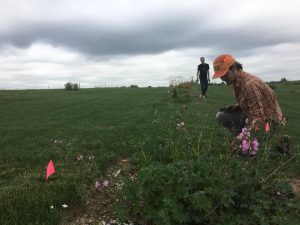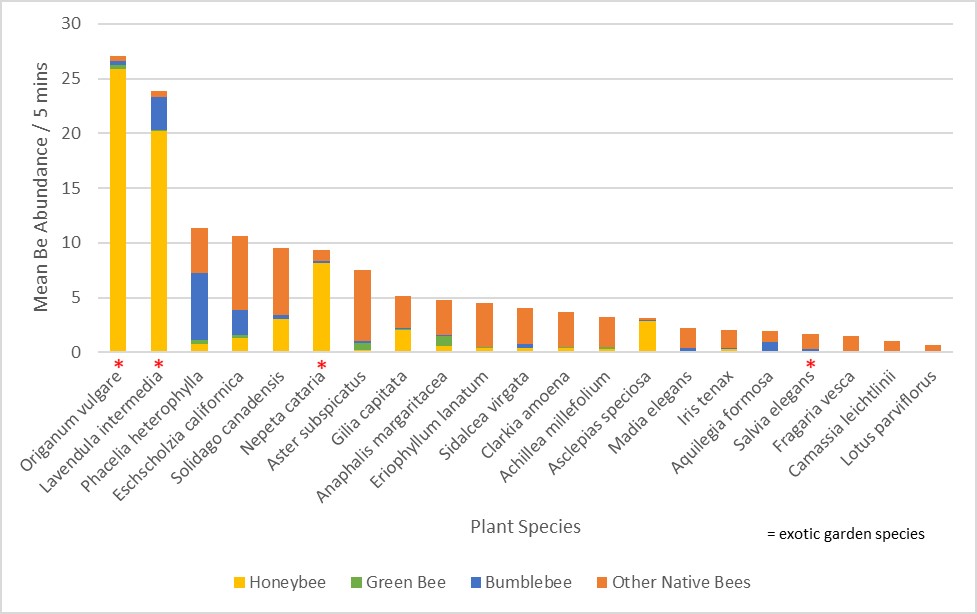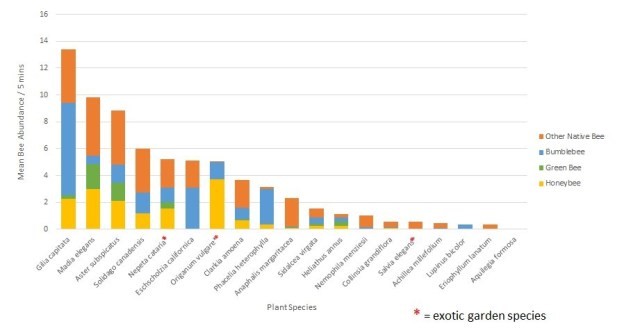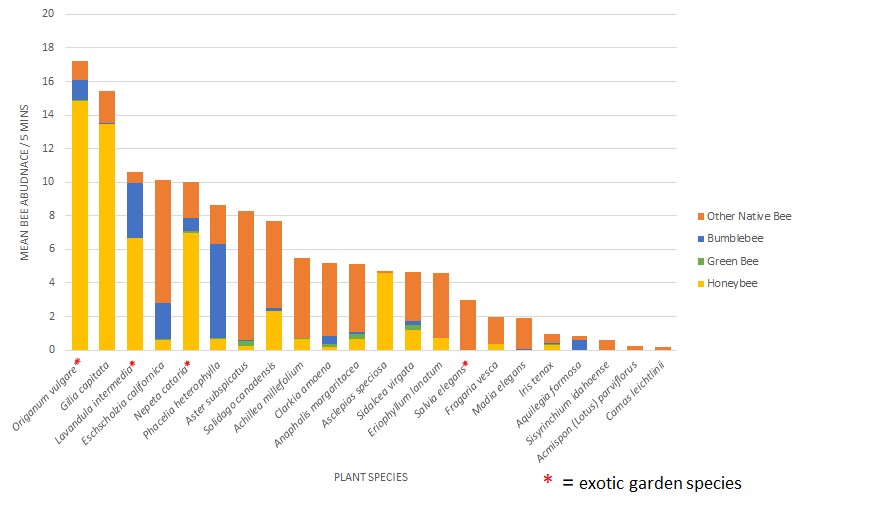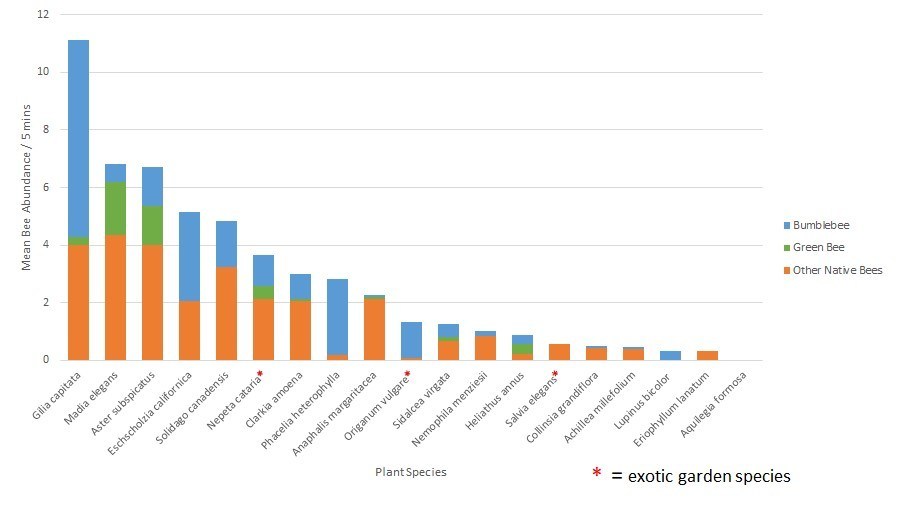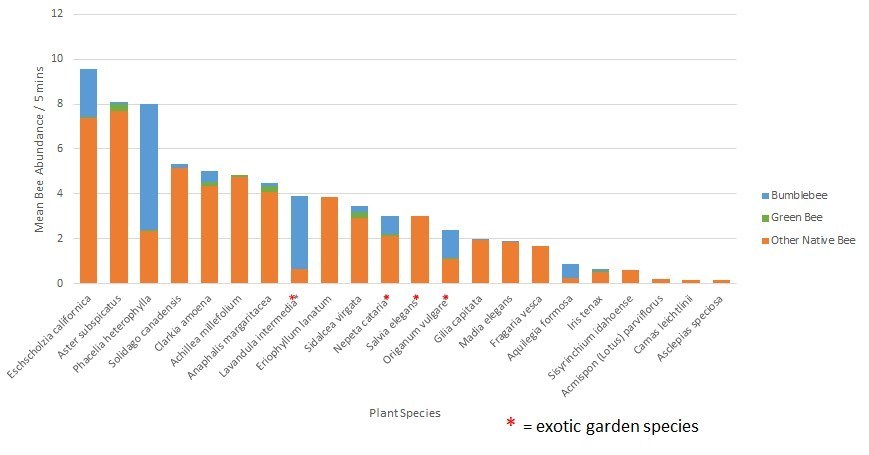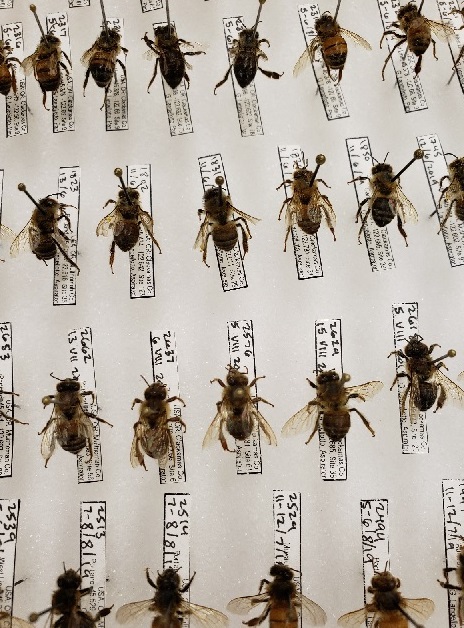This article is the third in a five part series that I am writing for the Hardy Plant Society of Oregon (HPSO) Quarterly Magazine. I am grateful to the team at HPSO for their editorial skills and feedback. Part 1 (overview, and gardens as ‘islands’ in an urban ‘ocean’), and Part 2 (putting a price on nature) of this series can be found in earlier blog posts.
*************
I distinctly remember the day that I decided I wanted to study wild bees. I was sitting in a darkened auditorium at the American Museum of Natural History in New York City, listening to Claire Kremen deliver the plenary address in a symposium focused on invertebrate conservation.
In her address, Dr. Kremen shared the results of her research on watermelon farms in California’s Central Valley. Like all cucurbits, watermelon requires insect pollination to set fruit. Watermelon, in particular, has a high pollination requirement: it takes at least eight bee visits to deposit the 500-1,000 viable pollen grains needed to set harvestable fruit in seeded watermelons. Seedless watermelons require between 16 and 24 visits by a bee in order to set fruit. Most growers meet the high pollination requirement of melons by renting and placing honey bee hives in fields. Dr. Kremen’s research suggested that a different approach might be possible.
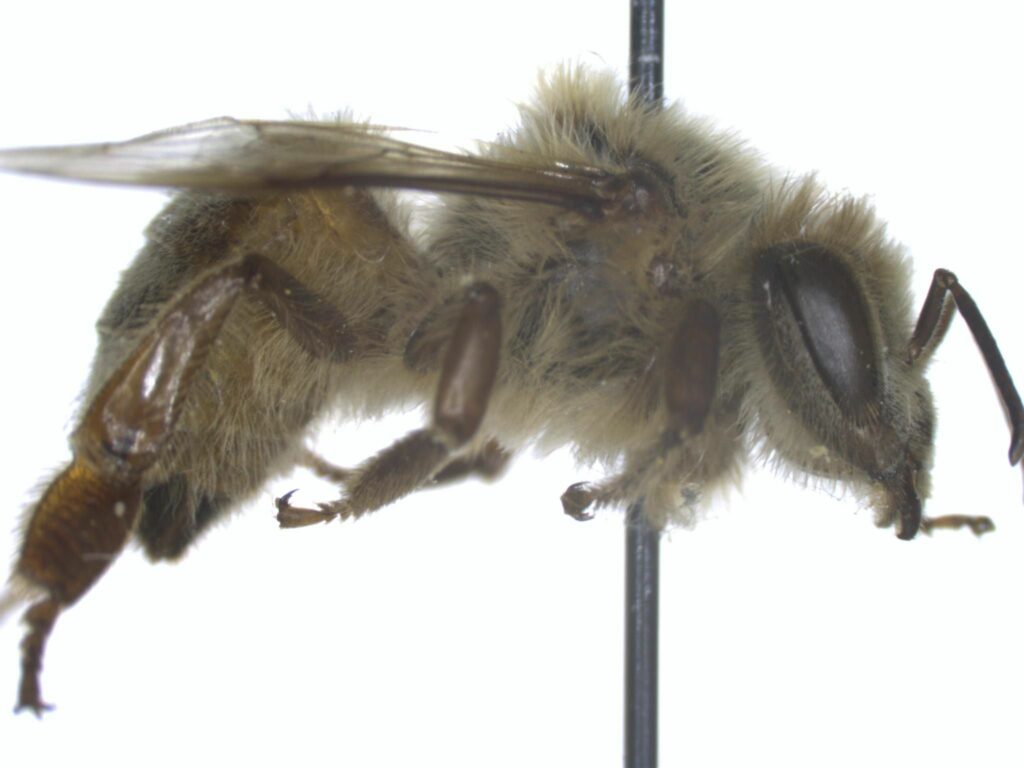
Dr. Kremen and her colleagues studied three types of watermelon fields that varied in their pest management practices (organic or conventional) and their proximity (near or far) to native habitat in the foothills of the California coast range. These fields were: organic near, organic far, and conventional far. Watermelon fields that used conventional pest management practices and that were located near the foothills were not included in this study because this type of farm did not exist in the region. The team determined the number of pollen grains that different bee species deposited on watermelon, by presenting different bees with a single watermelon blossom that had yet to receive any insect visits. After a blossom was visited by a single bee, the flower was bagged and tagged accordingly, and the number of pollen grains deposited on the stigma by that single bee was counted in the lab. They repeated this process for 13 different bee species.
Next, the team sat in watermelon fields and observed what types of bees visited watermelon blossoms, in different types of farm fields. Watermelon flowers are only receptive to pollination visits for a single day. They recorded the sex and species of each bee visitor to the blossoms. Based upon these species specific counts, combined with the pollen deposition data (above), they were able to assess how much each particular bee species contributed to the production of harvest-ready watermelon.
Dr. Kremen found that pollination surpassed 1,000 pollen grains needed to set harvestable fruit per flower in the organic near fields but not in the organic far or the conventional far field (Fig 1, part A). Furthermore, she found that this outcome could be tied to the greater diversity and abundance of bees in organic near fields, compared to the other two types of fields (Fig 1, part B).
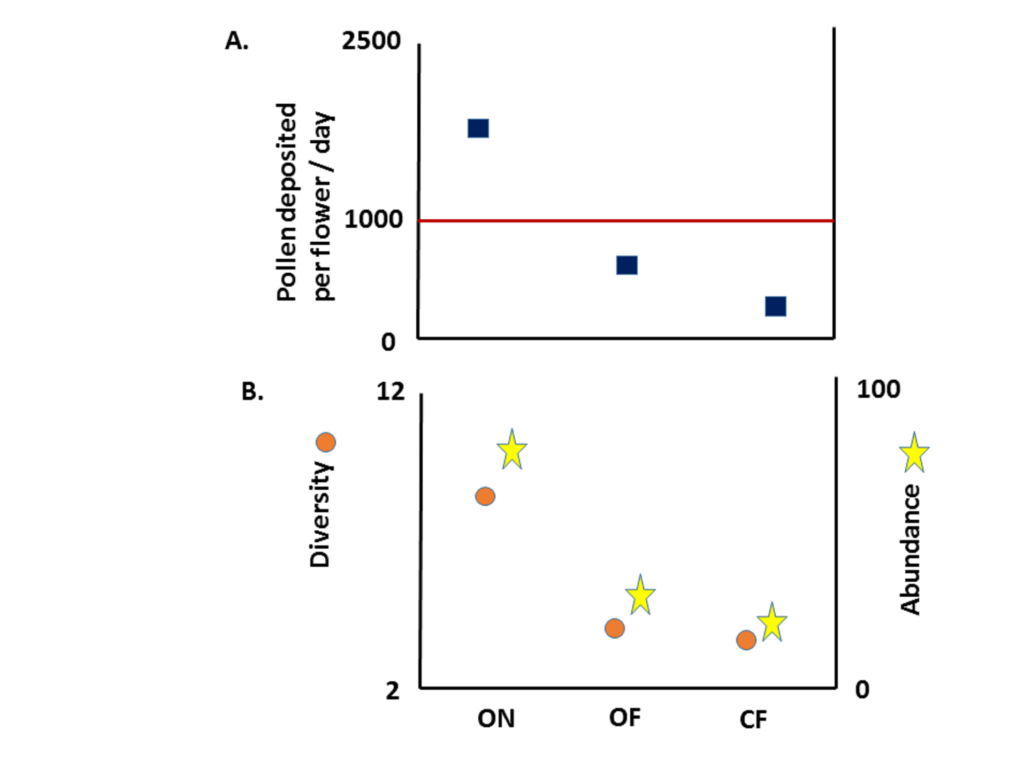
Dr. Kremen also found that, even though no single species of wild bee was as effective as managed honey bees, the collective group of wild bees surpassed the effectiveness of honey bees in organic near fields (Figure 2). Interestingly, honey bees were most effective as crop pollinators in the conventional far fields and least effective as crop pollinators in the organic near fields. This may be because few other flowers were in bloom in the conventional far fields, so that honey bees concentrated their attention on the crop at hand. In the organic near fields, a greater diversity of flowering plants likely competed for the pollination services of honey bees.

Wild bees were able to fully satisfy the pollination requirements of a crop with an extremely high pollination requirement because broad spectrum insecticides were not used, and the foothills provided year-round and protected habitat for the bees. This story blew my mind!
Prior to that conference, I had never given wild bees much thought. They’re mostly solitary nesters, with small bodies, that only forage for a few days to a few weeks. They tend to be inefficient foragers, particularly when compared to the juggernaut of a honey bee hive. Whereas wild bees are akin to a single vendor on Etsy, honey bees seemed the unbeatable Amazon!
Dr. Kremen’s work showed the potential value that wild bees have to agriculture. And her work was published just prior to the global onset of colony collapse disorder in honey bees in 2006. It set off a worldwide discussion about what to do about honey bee losses. Should scientists put time and effort into saving a single, non-native species (the honey bee), or should we work to conserve or build habitat around farm fields while also reducing insecticide use?
I was incredibly hopeful that the simultaneous threat to honey bees and promise of wild bees might promote heavier investments in agroecology, including the conservation of bee-friendly habitat around farms. During this time period, I was also in the early stages of documenting wild bee biodiversity in community and residential gardens, and I was surprised that abundance and diversity of garden bees was much higher than I had anticipated.
Back in 2004, I started to see gardens, and the abundance and diversity of wild bees that they host, as a potential solution to the problem of colony collapse disorder. Although I continue to be fascinated by the potential role of home and community gardens as a safe haven for bees from agricultural stresses, the urgency of this question has faded. Colony collapse disorder does not currently plague honey bees, due in large part to federal investments in studying, understanding, and mediating the factors that contribute to failing hives. With honey bees doing much better, attention has somewhat faded on the potential role of wild bees as crop pollinators. Still, work in this area continues and may rise to renewed importance, should colony collapse disorder again present a major challenge to United States agriculture.
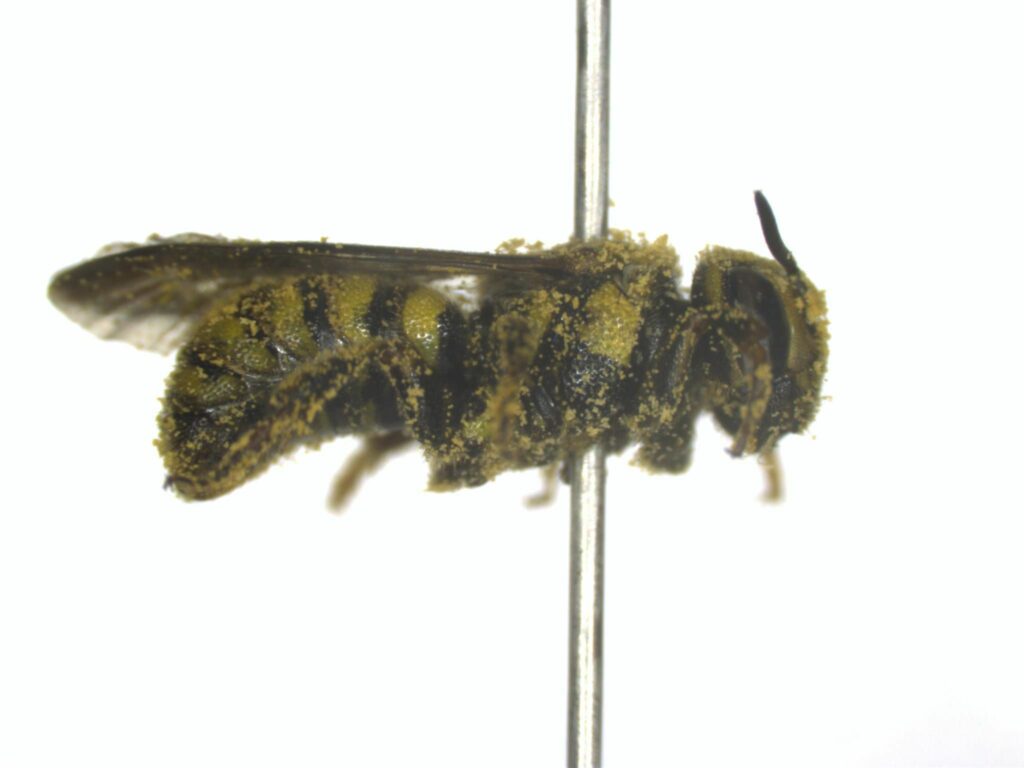
Kremen, Williams, Thorp. 2002. Crop pollination from native bees at risk from agricultural intensification. Proc. Natl. Acad. Sci. 99: 16812-26816. DOI: 10.1073/pnas.262413599.

